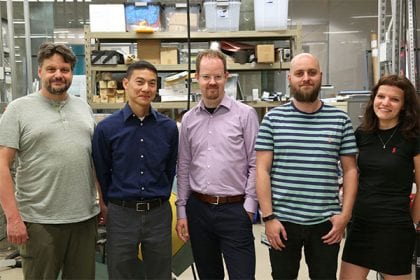Modern microscopy has given scientists a front-row seat to living, breathing biology in all its technicolor glory. But access to the best technologies can be spotty.
Jan Huisken, a medical engineering investigator at the Morgridge Institute for Research and co-founder of light sheet microscopy, has a new project meant to bridge the technology gap.

The Flamingo team (from left): Todd Bakken, Joe Li, Jan Huisken, Rory Power and Susi Power.
His Morgridge team has developed a portable, shareable light sheet microscope — an engineering feat that shrinks a tabletop-sized technology down to the weight and dimensions of a suitcase liberally packed for a week’s vacation. The project can be mailed to a lab anywhere in the world, configured remotely by Morgridge engineers, and run one to three months of experiments.
The microscope then either begins its mail-order journey to the next lab, or back to the Morgridge lab if a tune-up is needed — all at no cost to users. The first focus will be on sharing with the University of Wisconsin–Madison community.
“If we succeed, this project will certainly have a huge impact in the field of fluorescence microscopy and significantly change the way we collaborate,” says Huisken.
The technology targets two essential challenges.
Labs lucky enough to afford a commercial microscope can keep their entire experiments in-house. But as biologists, not engineers, customizing from one project to the next is difficult and the expensive tool may drift into obsolescence, says Huisken.
The budget-challenged may need to take their project to the nearest shared microscopy resource. But biology doesn’t travel well: Delicate samples may get altered or ruined along the way, and experiments may fail in the unfamiliar environment, he says.
The team debuted the tool — nicknamed “Flamingo” for its one-legged stand and vertical profile — today (June 20, 2018) at the International Zebrafish Conference meeting at UW–Madison. It’s the perfect starting point for this device, since the zebrafish research community wants to use light sheet microscopy.
What is light sheet? Huisken’s microscopes illuminate samples from the sides with non-invasive “sheets” of light, giving scientists the ability to image samples over hours or days from every angle. This helps generate a tremendous amount of data quickly and gives researchers a 3D view of development in an almost completely unaltered state.
Zebrafish researchers use the technology because it can build striking movies of embryo, limb and organ development. But it’s also being adopted by other model organisms important to research, such as fruitflies and planaria, and for imaging early plant root growth.
Susi Power, a Huisken lab member on the Flamingo development team, says the lab has been seeing for years the challenges biologists face in getting access to good imaging. One of the added benefits of this project will reflect back to the Huisken lab as a kind of research crowd-sourcing. In exchange for using the technology, the lab helps expand the light-sheet user community and gets continual feedback on how to improve its core technology.
“I think it does something magical for a biologist to have a technology like this entirely to themselves, where they can set it up and say, ‘that’s my Flamingo,’” Power says. “I think there will be a huge reward to the science.”
The prototype device is built and ready to use. Ongoing work includes designing remote access to help calibrate the device from Morgridge, and building software that will give users real-time desktop and mobile access to the data.
Power says the microscope is the opening project in a new Huisken lab initiative called “involv3d,” which is intended to improve collaboration and communication between different research disciplines. The Huisken Lab has active members in developmental biology, medicine, physics, botany and others, and they want involv3d to bridge these fields and “help scientists profit from other scientists.”
Liz Haynes, a postdoctoral fellow in the lab of UW–Madison neuroscientist Mary Halloran, says Flamingo will help address some challenges in the Halloran lab. The lab needed a technology that could track the neurodevelopmental consequences of gene editing changes made in zebrafish embryos, and traditional approaches were onerous.
She’s looking forward to being one of Flamingo’s first customers.
“I’m also excited because it is a beautiful scope and it seems really smartly designed,” Haynes says. “It’s a joy to look at. And, of course, the images you can get from (light sheet) are breathtaking.”
